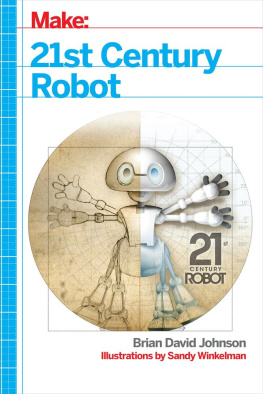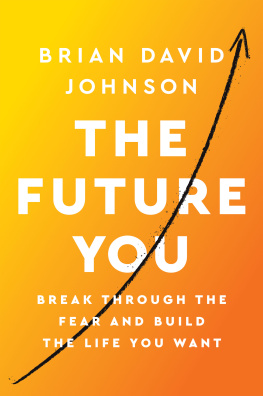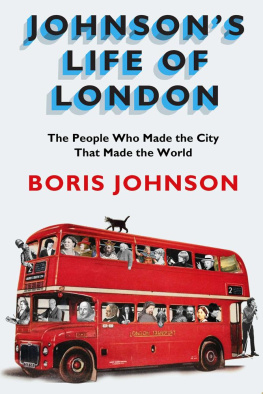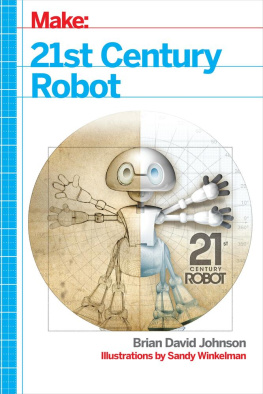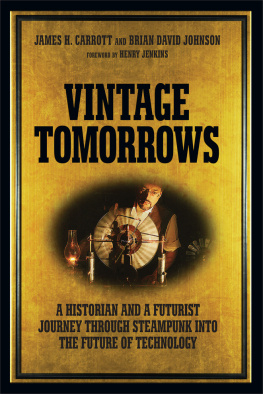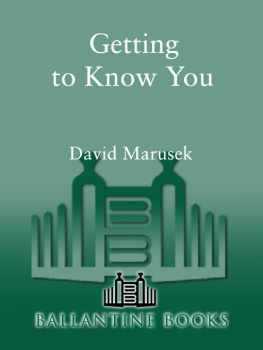This book and the entire 21st Century Robot Project is dedicated to anyone born after 2014.
Today we have an entire generation of young minds that has grown up never knowing a time when there wasnt an Internet. This generation has never known a time when you couldnt walk up to a screen, ask it for something, and get a response in under a second. Its truly amazing. In fact, if this generation is given a screen and its not connected to the Internet, then that screen is broken. I am constantly surprised and amazed at the ideas and creativity of this generation. I cant wait to see what they do.
This book is dedicated to anyone born after 2014 because it is my hope that they will be the generation that has never known a time when they couldnt imagine, design, build, program, and share their robots. Just imagine the incredible, silly, and awesome things they will build!
If you are reading this book, then you have a responsibility to this generation.
We can make this future real.
The Making of a Manifesto
This book ends with a little robot standing backstage in Las Vegas, about tomake his dbut in front of 5,000 people. The little robots name is Jimmy, andhes the first 21st Century Robot.
You might be asking yourself: what is a 21st Century Robot?
Good question.
For most of their history, robots have only lived in science fiction. Long before the technology to build themwas ready, robots could only be seen or experienced in science fiction stories,movies, comic books, and often times only in toys. But that didnt stop people from imaginingrobots and exploring their implications. In fact, cultures all over the worldhave imagined and explored the implications of robots, long before the word wascoined by Czechoslovakian writer Karel apek in 1920.
In the last half of the twentieth century, robots began their journey from ourimaginations to the real world. Industrial robots started to help us build ourcars and work in our factories. Research robots of all shapes and sizes weredeveloped and built in university research labs. But even with all these newrobots making their way into the world, for most people, robots were stillexotic and foreign, still the product of science fiction and our imaginations.But then something happened
Around the turn of this century, robots became something very different. Nolonger were they creations locked away in large universities and corporations.In the twenty-first century, robots became something anyone could build; a part of ourdaily livesright where they belonged.
The twenty-first century brought a whole new way to design, build, and program robots.Technological advances and different approaches to development gave us new tools,removing the barriers that had separated us from robots. Open source softwareand apps gave us a whole new way to develop and share computer code. Open sourcehardware tapped into the creativity of millions of smart developersand non-traditional builders. The emergence of 3D printing gave anyone theability to manufacture their own robot designs. The world had changed.
Now anyone can imagine, design, build, and program their own robot. These newrobots are truly 21st Century Robots.
As a futurist, its my job to look out into the future and model how people willact and interact with technology. Essentially, I envision what it will feellike to live 10, 15, even 20 years in the future. I have been thinking about andimagining new 21st Century Robots for a decade (more about that in the nextchapter). Then, about three years ago, it became clear that technology hadprogressed to the point where the robots Id been imagining for 10 years werenow possible. These robots would be completely open source, 3D printed, andabove all else, social. They would set themselves apart from any robot that hadcome before them. That revelation gave birth to this book.
A Manifesto Is Born
So what makes a 21st Century Robot different from a twentieth-century robot? DaleDougherty, the CEO of Maker Media (my publisher), asked me on a phone call at thebeginning of the project. Infinitely curious and always a huge supporter of thisnew approach to robots, Dale pushed me to define what I meant by 21st CenturyRobots.
Well, I replied, standing in my kitchen staring at the phone, Id say that a21st Century Robot is imagined first. Its certainly social, open source, anditerative, but its also filled with the hopes and dreams of the people that madeher, him, or it. Its also easy to build!
So its up to the people who build the robot? Dale asked. Is that a 21stCentury Robot?
We dont know, I replied. Thats the really great thing about it. When itcomes to a 21st Century Robot we really dont know what it is. I dont knowwhat it is. Its not up to me. Its up to the person who is building the robot.Every robot is personalized. Every robot is an individual. Every robot shouldhave its own name, because every 21st Century Robot is an individual,because every robot is built by a person.
I think you need to write a manifesto, Dale said with a laugh. I think youactually just wrote one.
Ive never written a manifesto, I answered. I didnt know people still wrotemanifestos.
Just answer this question: what makes a 21st Century Robot different from atwentieth-century robot? What makes it different from anything else that has comebefore?
And thats how a manifesto was born in my kitchen in Portland, Oregon. Thisis what I came up with
21st Century Robot Manifesto
In the twenty-first century, technology has progressed to the point where what webuild is only constrained by the limits of our imaginations.
Its time to imagine a radically different kind of robot. A robot that is designed, constructed, and programmed like never before. We can imagine and build a far more amazing future than we have todaya much more creative and rich tomorrow for robots and their relationship to humans. Its time for a 21st Century Robot. This is our manifesto:
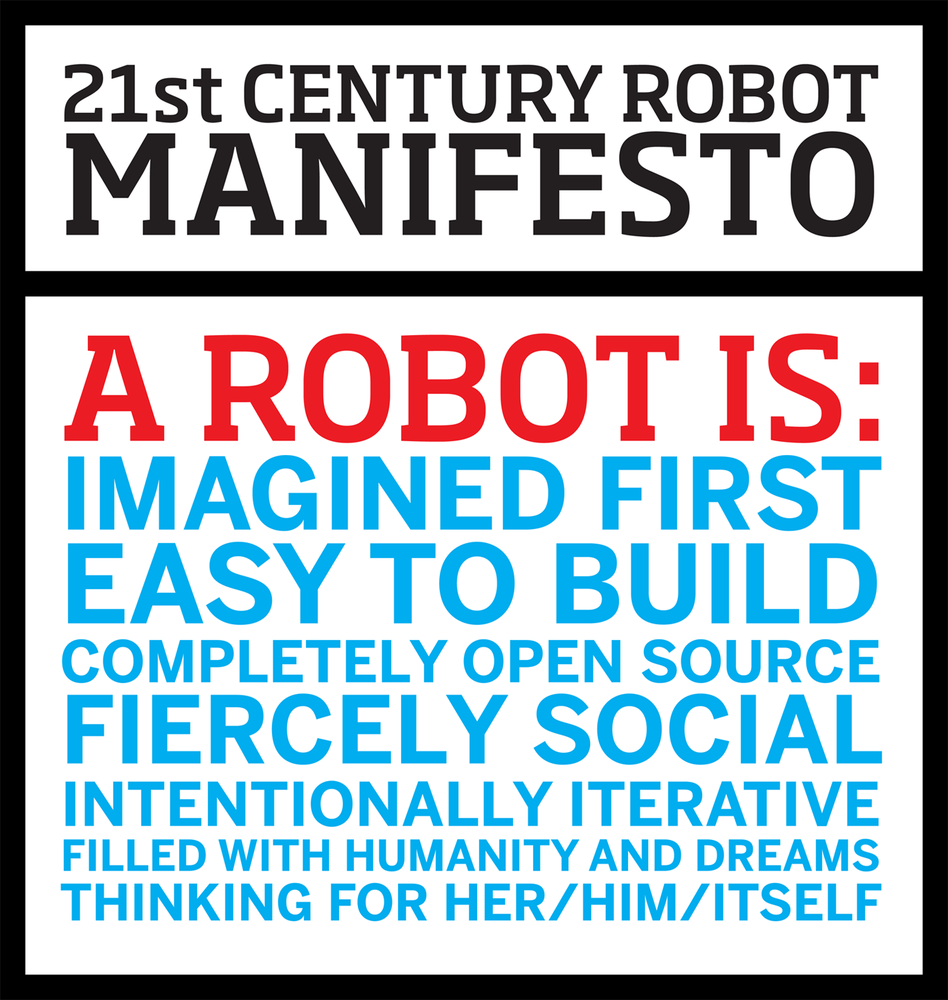
Imagined First
Nothing was ever built by humans that wasnt imagined first.
Imagination is the most important skill needed to build your robot. In the twenty-firstcentury, anyone can imagine, design, and build a robot.
But first you must ask yourself: who do you want your robot to be? What is yourrobots name? (Because every robot has a name.) Every robot is an individual.How do you want to act and interact with your robot? What would your robot dothat is special? What would your robot do that no one elses would do?
Draw a picture of your robot. Write a story about what it would be like to live with your robot each and every day. What new, wonderful things would your robot do? What could go wrong? What should we avoid? Your imagination and these ideas will make your robot an individual.
Science fiction stories, comics, and movies are powerful tools that can help youto imagine your robot. We can use science fiction, based on science fact, todesign robots, and share those stories as a technical requirements document.
Easy to Build
Back in the twentieth century, building a robot was hard. Computers were massive andslow. Electronics were complicated, and the manufacturing process was reservedfor just a handful of people who had the money to build factories and assemblylines. But all thats changed.
Today computers are small and easily accessible. Software tools and apps allowanyone to be a programmer or designer. 3D printers have lowered the barrierbetween the digital and physical worlds, allowing us to manufacturenearly anything we can dream up. There are entire communities,events, and places where you can go to design and print your robot.

